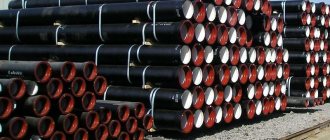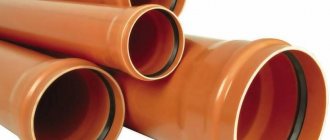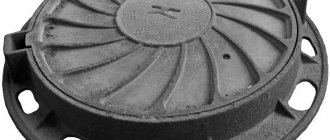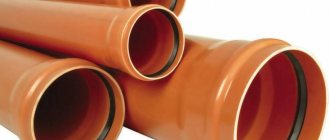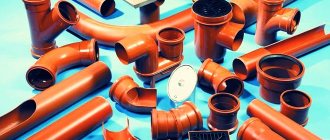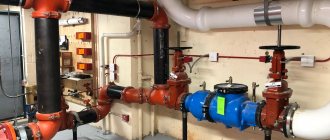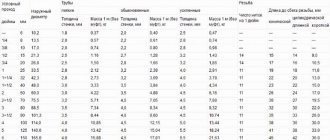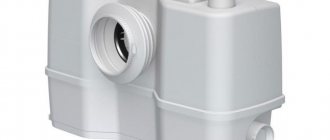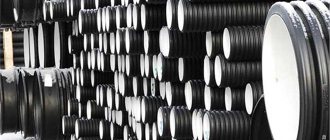Cast iron sewer pipes and fittings for them, manufactured in accordance with GOST 6942–1998, have been used for a long time for laying pipelines inside buildings and external highways. In some cases, cast products are preferable to pipes made using other technology. The obvious advantages of cast iron pipeline fittings include:
- material strength, therefore good pressure resistance;
- high resistance to internal surface wear and corrosion;
- cast iron pipes are used for pumping liquids with aggressive chemical properties;
- good sound insulation properties;
- there are no longitudinal connecting seams or fistulas on the surface of the pipe;
- long service life;
- it is possible to pump liquids with temperatures up to 60ºС;
- the environmental friendliness of cast iron structures will not disturb the surrounding atmosphere and soil;
- accessibility to a wide range of consumers due to the low cost of cast iron as a material.
The disadvantages of using cast iron for sewer pipelines are the significant masses of products, and the complication of installation work for this reason.
Cast iron pipes for sewerage are distinguished by type of connection . They are produced with or without a bell. The bell is a ready-made expanded coupling, which provides for the installation of a rubber sealing ring. If the socket is not provided for in the technical documents for the construction of the main line, then a pipe equal on all sides is made, connecting to the next one using a special stainless steel clamp. A rubber seal must be installed.
Modern cast iron products are distinguished by a beautiful appearance with uniform coloring and treatment with anti-corrosion compounds inside and out. Products with chips on the edges of pipes and sockets are no longer delivered to the customer; they are rejected at the technical control stage.
Advantages and disadvantages of polymer and cast iron parts
One of the main advantages of parts made of polymer material is that they have a smooth structure inside the product itself, which significantly reduces the risk of contamination or clogging of the hole, which may well happen due to accumulating deposits. Thanks to such a smooth base, deposits are not retained; all impurities pass through the product without hindrance.
They are also able to withstand high temperatures, which makes them more popular in everyday life. They are not exposed to detergents often used in everyday life.
Shaped parts for sewer pipes made of polymer material have a number of advantages, such as:
- Installation does not take much time. To implement it, no special skills or abilities are required.
- Compared to cast iron products, they are light in weight.
- Durable to use.
- They are resistant to high temperatures and ultraviolet rays.
- Not subject to decay.
- A large assortment allows you to choose the part of the required shape and diameter.
- Used for both external and internal laying.
Cast iron has proven itself to be a fairly durable material. But compared to PVC, it is susceptible to corrosion, which over time will make the parts unsuitable for use. Often, after such situations arise, replacement of shaped products is required. The advantage of cast iron fittings is their durability. They can function for decades without requiring replacement or repair. It all depends on the quality of the water that will pass through these parts.
The downside is also their weight. They are quite heavy, which can significantly complicate their installation. One of the advantages is that they can last quite a long time. Cast iron itself is a very durable and strong material; it is much more difficult to damage than a polymer material.
Pipe fittings
Advantages and operational scope of cast iron pipes
Like any other product, a cast iron pipe has its advantages. Let's consider the advantages of cast iron parts over modern plastic ones:
- they are distinguished by high strength characteristics;
- cast iron pipes are wear-resistant;
- cast iron has good soundproofing properties;
- parts made of this material are fire resistant;
- are resistant to temperature fluctuations;
- have a low stretch coefficient.
Helpful information! These products are regulated by the relevant state documentation (GOST). According to GOST, cast iron parts for sewer networks are best used for installation inside structures in which the load exceeds economic standards.
Let's consider in what cases it is recommended to lay pipes made of cast iron:
- at industrial enterprises that belong to the food industry;
- in factories;
- on farms;
- in buildings equipped for sanatoriums (if there is access to geothermal sources);
- in buildings equipped for healthcare purposes;
- in educational institutions.
Cast iron pipes are suitable for underground and above-ground drainage systems
Cast iron pipes are heavy, so their installation is quite labor-intensive. Products with large cross-sectional dimensions require the use of special equipment during installation.
Rules for acceptance and labeling of products
The raw material for the manufacture of pipes and fittings is gray cast iron with the addition of lamellar graphite, corresponding to GOST 1412. Casting is carried out in accordance with GOST 26358. Products must be coated with an anti-corrosion coating on the inside and outside, which have a softening temperature of at least 60 ° C (333 K).
Marking of pipes and fittings is applied with indelible paint. It includes:
- manufacturer's trademark or name;
- symbol of products;
- performance standard.
Products are tested for compliance with the following requirements:
- In terms of the presence of chill: half a percent of products from the total batch volume.
- 100% of the products in the batch must be free of defects and have a suitable type of anti-corrosion coating.
- In terms of deviations from dimensions (nominal), wall thickness, weight, straightness, withstand pressure and stickiness of the anti-corrosion coating: at least 2% of products from the entire batch.
The manufacturing plant applies markings to the pipes that contain data on the characteristics of the pipe
The composition must be applied in a continuous, smooth, non-sticky, durable layer, without bubbles or cracks.
Characteristics of crosses
When installing communication systems, it is important to consider the pipe branching factor. Using a cross for these purposes allows you to save space and use the material most efficiently. Branching occurs in two planes. Document 6942 contains the characteristics of the crosspieces. The angle between the primary and secondary axis is 87° 30′ with a tolerance of 1° 30′.
Note! The mass of straight crosses with an offset axis of removal is 7.6 kg. The axis shifts by 25 mm.
The characteristics of oblique crosses at 60° with a permissible deviation of 1° 30′ are given in the table. Linear dimensions are given in centimeters.
Table 13
| Conditional passage: main/branches | 5/5 | 10/5,0 | 10/10 | 15/5 | 15/10 |
| Distance from branch point to socket | 6,2 | 8 | 11,0 | 9,2 | 12,2 |
| Distance from branch point to shank | 10,8 | 9,5 | 12,5 | 8 | 10,8 |
| Distance from branch point to outlet socket | 6,2 | 9 | 11,0 | 12,0 | 13,5 |
| Weight without anti-corrosion coating, kg | 3,0 | 5,8 | 5,8 | 7,0 | 10,0 |
The characteristics of oblique crosses at 45° with a permissible deviation of 1° 30′ are given in the table. Linear dimensions are given in centimeters.
Table 14
| Conditional passage: main/branches | 5/5 | 10/5,0 | 10/10 | 15/5 | 15/10 |
| Distance from branch point to socket | 9,0 | 11,5 | 15 | 14,0 | 18,0 |
| Distance from branch point to shank | 10 | 7,5 | 11 | 8,5 | 8,5 |
| Distance from branch point to outlet socket | 9,0 | 12,5 | 15 | 16,0 | 18,8 |
| Weight without anti-corrosion coating, kg | 4,0 | 6,9 | 10,5 | 7,3 | 10,5 |
Two-plane crosses according to GOST 6942 are available in left and right versions.
Sequence of installation work
General rules for laying pipelines
It is carried out according to the general rules applied in all sewer lines. When transporting and laying using lifting mechanisms, gentle gripping devices that do not damage the anti-corrosion coating of the top layer. Individual pipes or sections of the main line assembled together are rearranged.
All stages of intermediate and permanent activities must be reflected daily in the work log, indicating the volume produced, compliance with design requirements, the depth of laying the next section and the option for strengthening the trench walls.
When installing the design slope of a free-flow sewer cast iron pipeline, pipes with sockets are laid along the trench with the wide part up. Carrying out a straight section between two wells, perform a visual inspection of the light using a mirror. This check is done before the soil is completely backfilled , and the gap should be round in shape. A horizontal deviation of no more than 50 mm in each direction is allowed. Vertical deviations are not permitted.
Deviation from the design axis of external pressure mains in plan is allowed, which cannot be more than 100 mm. Markings of free-flow trays do not have a height deviation of more than 50 mm. These requirements are standardized for all types of sewer routes, and if requirements other than those in GOST are provided, they are specified in the technical passport for the facility.
The pipeline is laid along a curved line, the joining of the sockets is carried out only with the installation of rubber gaskets. For mains made of pipes with a diameter of up to 600 mm, it is allowed to turn the pipe only by 2º. Pipes with a diameter of more than 600 mm are allowed to be rotated only 1º.
When connecting, cast iron pipes are centered so that the straight tail of the pipe entering the socket forms a gap equal around the perimeter, which must subsequently be sealed with cement mortar. Rubber seals must comply with the quality stated in GOST; in winter conditions, they are defrosted before being installed in the working position.
Joint sealants and sealants are those developed in technical documents and specified in the project. The flange connection must comply with several rules:
- flanges are installed perpendicular to the design center line;
- with a flange connection, the heads of all bolts are placed on one side of the connecting plates, they are gradually tightened according to the principle of a cross;
- installation of spacers to level verticality and grinding of edges is not allowed;
- connecting planes are checked before installation, but uniformity and curves are rejected and not installed;
- Connection of nearby sections of the pipeline is carried out only after tightening the flange connection.
If a trench wall is used for additional support, they try not to disturb its solidity with digging. If reinforced concrete supports are used for installation, then the gaps between them and the cast iron pipe are sealed with cement-sand mortar. Work completed and then hidden under the surface layer of soil must be documented with special documents. Drawing up an act for hidden work is carried out in the following cases:
- works on preparation and construction of the foundation;
- installation of supports made of reinforced concrete and other materials;
- if gaps in butt joints were eliminated, then the method of sealing and the use of seals are indicated;
- wells for any purpose were built or installed;
- implementation of anti-corrosion protection of individual areas;
- waterproofing was carried out at the intersections of the pipe with the walls of wells or other sewer connections.
Laying cast iron pipes with socket joints
The straight part of the pipe is inserted into the socket of the previous one. The gap formed at the junction is sealed with tow and cement-sand mortar in the standard case. The tow is driven tightly into the gap using non-metallic tools to preserve the intact surface of the cast iron pipe. Instead of cement mortar, it is allowed to use special modern sealants, which are regulated by special GOSTs.
To make fixed-degree turns, special shaped parts made of cast iron, crosses, bends at different angles and tees are used, made of a material of the same composition as the pipes themselves. In modern docking options, elastic seals are installed, which ensure reliable docking and tightness of the connection.
Installation of cast iron pipes without socket
In recent years, cast iron pipes have gained popularity, which are made without expanding the end part - the socket. They are joined using separate clamps made of stainless steel.
The connection of cast iron pipes is made end-to-end. The clamp is delivered to the site complete with a rubber ring, which has the ability to withstand aggressive chemical irritants and in this case retains its insulating properties.
The connection is covered with a cuff around the perimeter, and then a steel clamp is installed, tightened with a bolt and nut until it stops. If the design of the sewer system involves pumping wastewater under high pressure, additional requirements are imposed on the connection point. To increase strength, another crimp casing is installed on top of these materials. The convenience of connecting in this modern way is that it can be easily disconnected and returned to its working position during repair work.
Device for connecting a cast iron pipe to a plastic one
Sometimes it is necessary to connect two different materials together in a sewer line. To make the connection, the socket of the cast iron pipe must be cleaned, then dried with a rag . A rubber cuff is placed in the socket and its edges are treated with insulating silicone. After installing the plastic pipe, the connection is additionally insulated with sealant.
If a cast iron pipe that does not have a socket at the end is to be connected, then an adapter is put on the end of it, and the end of the plastic pipe is placed through the gaskets. For a more reliable connection, silicone is used.
How to lay a pipe under a road using the puncture method
Often the sewer line encounters an artificial barrier in its path in the form of a highway or railway tracks. To make a pass from below the obstacle, use the horizontal puncture method . Modern methods use an efficient drilling unit that is equipped with advanced control methods.
The puncture is carried out with a drill head. A special device is installed on it, emitting rays and transmitting a correction signal to a locator installed at the opposite end of the planned pipeline. The coordinator sees the entire process of passing the route under an obstacle on the display, interfering with the operation of the drill if necessary.
Then the process of expanding the trench occurs with the cutting blades of a special tool. Typically its width is one quarter larger than the cross-section of the pipeline being laid. Then comes the automated process of laying pipes. Calculate the required length of the pipes and place them at the entrance to the trench. A hinged device is connected to them, which moves forward with a translational movement to the opposite end of the puncture and pulls the pipes along with it.
Dismantling and disassembly of cast iron sewer line and connections
This work is classified as difficult, since it is sometimes not possible to disassemble the joint between two cast iron elements without breaking it. Over time, the joining planes and seams become overgrown with lime salts, and the weight of the products is quite large. For disassembly, it is recommended to use a large mallet-type hammer, a grinder saw and other tools that are at hand.
In accordance with safety requirements, work on dismantling cast iron sewers is carried out wearing safety glasses and a respirator to protect the respiratory system.
If there is no need to keep the remains of the sewer intact, then it is better to break them up in random order and throw them away. If you are replacing only a certain section, you should try to leave the sockets of the sewer pipes intact, since with their help it is much easier to connect other parts of cast iron pipes.
Replacing a cast iron sewer riser in an apartment
First of all, you need to remain careful in your work so that pieces of broken pipes do not fall into the working risers and blockages do not build up around them. Therefore, you should tap the joints with a mallet, trying to knock out the cement mortar and remove the tow. If the seams have been cleared of mortar and sealant, then try to pull the end of the pipe out of the joint using circular rotational movements.
The work will require a lot of patience, as this process cannot be rushed . They combine tapping with a mallet and, from time to time, performing rotation. Sometimes, in order to preserve the socket of the common riser in the house, they cut the apartment section of the pipe and take it out in parts along with the mortar and sealant. Most often, plastic is installed in place of a broken cast iron pipe.
If during the dismantling process a crack appears on a cast iron pipe that is still needed for operation, then the place is sealed with rubber gaskets and crimped with a casing. It is much less effective to use a bandage made of cement-sand mortar and gauze or other fabric on site.
Pipe sizes
A pipe is a shaped element of a cast iron pipeline, which is necessary to change the type of connection. This part is used to compare systems made of different materials.
To connect cast iron pipes, pipes are used, which are available in a variety of shapes and sizes.
GOST distinguishes between transition and compensation pipes. They are used in sewage systems for fecal and household wastewater in public, industrial and residential buildings.
Note! The compensation pipe is used when it is necessary to connect several sewage systems that differ in their structure.
The dimensions of the pipes according to document 6942-98 are given in the table. Linear dimensions are given in centimeters.
Table 7
| Conditional pass | Weight without anti-corrosion coating, kg | Construction length |
| 5,0 | 2,0 | 25 |
| 2,5 | 35 | |
| 2,8 | 40 | |
| 10,0 | 3,8 | 20 |
| 4,4 | 25 | |
| 5,7 | 35 | |
| 15,0 | 8,8 | 40 |
A special feature of the expansion pipe is the elongated socket. The parameters of such a pipe according to GOST 6942 must correspond to the table. Linear dimensions are given in centimeters.
Table 8
| Conditional pass | Weight without anti-corrosion coating, kg | Shank length | Bell length |
| 10 | 4,5 | 8 | 13 |
| 10 | 8,4 | 8 | 37 |
| 15 | 6,5 | 8 | 13 |
| 15 | 12,8 | 8 | 38 |
The linear dimensions (in centimeters) and weight of the cast iron adapter pipe are given in the table.
Table 9
| Conditional pass | Weight without anti-corrosion coating in kg | |
| Dy | dy | |
| 10,0 | 5 | 1,85 |
| 15,0 | 10 | 3,2 |
Application area
The assembly of a drainage system is most often carried out using products made from modern polymer materials. Cast iron sewer pipes GOST 6942-98 are more often found at industrial enterprises, where discharged water may contain a large amount of aggressive substances. This includes the following objects:
- Enterprises where livestock are kept and slaughtered.
- Enterprises where food is produced.
- Factories and plants.
Cast iron is used in the assembly of the following systems:
- Water pipes.
- Drainage.
- Heat supply.
- Pipeline.
- Ventilation.
Disadvantages and advantages of products
The disadvantages of cast iron pipes and fittings for them include their large weight, which requires the use of significant effort when laying a sewerage pipeline.
One of the disadvantages of cast iron pipes is their heavy weight, so transportation and installation often require the use of equipment
The process of connecting such communications is also highly labor-intensive. Installation requires more time than a similar process with products made from other materials.
Note! The installation of external sewerage networks often requires the use of special equipment so that installation work is carried out in full compliance with the rules and regulations.
However, cast iron products have many advantages. They have fairly high strength due to the features of casting and alloy. Reliable operation is guaranteed for decades. The lowest service life of such communications is 40 years, the highest is 80-100 years.
Neither sudden temperature changes nor its highest values deteriorate the parameters of cast iron pipes. The anti-corrosion coating reliably protects products from the aggressive effects of wastewater, rust formation and deposits. They have high fire safety and relatively low cost.
